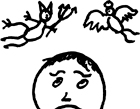

Imagine your memory wiped clean every couple seconds. This is the case with Clive Wearing.
In 1985, Wearing, an accomplished musician, was the happily married director of the choir at Covent Garden. Then he contracted a virus that ate the portion of his brain responsible for coding new memories (losing much of his long-term memory, as well). Quoted in the New Yorker, his wife, Deborah, writes in her memoir Forever Today, “His ability to perceive what he saw and heard was unimpaired. But he did not seem to be able to retain any impression of anything for more than a blink. Indeed, if he did blink, his eyelids parted to reveal a new scene. The view before the blink was utterly forgotten.”
Wearing stayed trapped in 1985, only things inexplicably changed in his world—a door was open instead of closed; Deborah was there, and then gone; things popped into and out of existence. But, almost cruelly, Wearing retained bits of implicit memory—somewhere in his unconscious he was able to grow and retain the impression that something was very wrong with him. And while he couldn’t remember the names of prime ministers, he might blurt out “John Major Vehicle” when looking at a car with license plate JMV.
Also, somewhere in his less-than-conscious memory, Wearing held on to his ability to play music. Deborah writes, “Clive could sit down at the organ and play with both hands on the keyboard, changing stops, and with his feet on the pedals, as if this were easier than riding a bicycle.”
And Wearing was not simply living in the moment of one bar of music, followed by the next bar, repeating the process until the bars ran out—he demonstrated phrasing that depended on knowledge of what had come before, where he was in the moment, and what would come after. In fact, Oliver Sacks writes in the New Yorker that while playing a piece of music, Wearing’s memory would completely refrain from hitting the reset but, “without performance, the thread is broken, and he is thrown back once again into the abyss.”

Self-Test: A Simple Memory Test
Look at this shape for ten seconds. Then try to draw it from memory.
